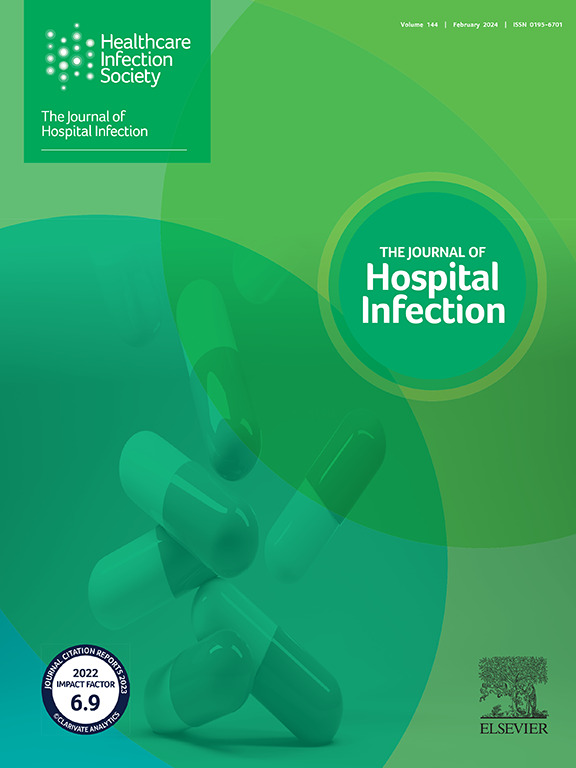Effect of tissue adhesive application on central line-associated bloodstream infections: a multi-centre retrospective study
IF 3.9
3区 医学
Q1 INFECTIOUS DISEASES
引用次数: 0
Abstract
Background
Use of central venous access devices (CVADs) has been plagued by various adverse events, including central line-associated bloodstream infection (CLABSI), inadvertent dislocation, exit-site haemorrhage, and local infection.
Aim
To investigate whether tissue adhesive (TA, 2-octyl blended with n-butyl cyanoacrylate) application to centrally/femorally inserted central catheter (CICC/FICC) exit sites could reduce the occurrence of CLABSI.
Methods
This retrospective review with historical controls was conducted in three tertiary care institutions. The TA group was established from December 2021 to July 2022 with the simultaneous initiation of TA application to the exit site of CICCs/FICCs. Patients in the control group received CICCs/FICCs before TA application between February 2021 and November 2021. Adverse event rates, including CLABSI, oozing, dislocation, and skin problems, were compared between groups. Risk factors were analysed using inverse probability of treatment weighting (IPTW)-adjusted Cox analysis.
Findings
The TA group comprised 1061 patients; the control group included 1049 patients. The CLABSI rate was significantly lower in the TA group (1.84 per 1000 catheter-days) compared with the control group (3.66 per 1000 catheter-days), with a rate ratio of 0.5 (95% confidence interval: 0.28–0.87; P = 0.01). The oozing rate was significantly lower (TA: 120; control: 158; P = 0.01). IPTW-adjusted analysis revealed TA as risk-reducing factor (P = 0.003), while age (P = 0.04) and triple-lumen (P = 0.04) were significant risk factors for CLABSI.
Conclusion
TA application at CICCs/FICCs exit sites could significantly lower CLABSI rates without serious adverse events.
组织粘接剂应用对中心静脉相关血流感染的影响:一项多中心回顾性研究。
目的:探讨组织粘接剂(TA, 2-辛酯与氰基丙烯酸酯正丁酯混合)应用于中央/股内中心导管(CICCs/FICCs)出口部位是否能减少中心线相关血流感染(CLABSI)的发生。方法:对三所三级医疗机构的历史对照进行回顾性研究。TA组成立于2021年12月至2022年7月,同时开始向中金/ ficc出口地点申请TA。对照组患者在2021年2月至2021年11月应用TA前接受CICCs/FICCs。不良事件(AE)发生率,包括CLABSI、渗液、脱位和皮肤问题,在两组之间进行比较。采用治疗加权逆概率(IPTW)校正Cox分析危险因素。结果:TA组包括1061例患者(中位年龄=62岁;四分位间距[IQR], 51-72;男性=549),而对照组包括1049例患者(中位年龄=61岁;差,50 - 72;男人= 516)。与对照组(3.66/ 1000导管-天)相比,TA组CLABSI发生率(1.84/ 1000导管-天)显著低于对照组(3.66/ 1000导管-天),其比率为0.5(95%可信区间,0.28-0.87;p = 0.01)。两组脱位率差异无统计学意义(p=0.45)。TA组出口部位瘙痒和水疱发生率略高于对照组(TA=36,对照组=25,p=0.16),渗漏率明显低于对照组(TA=120,对照组=158,p=0.01)。iptw校正分析显示TA是CLABSI的危险降低因素(p=0.003),而年龄(p=0.04)和三腔(p=0.04)是CLABSI的重要危险因素。结论:在CICCs/FICCs出口部位应用TA可显著降低CLABSI发生率,且无严重不良反应。
本文章由计算机程序翻译,如有差异,请以英文原文为准。
求助全文
约1分钟内获得全文
求助全文
来源期刊

Journal of Hospital Infection
医学-传染病学
CiteScore
12.70
自引率
5.80%
发文量
271
审稿时长
19 days
期刊介绍:
The Journal of Hospital Infection is the editorially independent scientific publication of the Healthcare Infection Society. The aim of the Journal is to publish high quality research and information relating to infection prevention and control that is relevant to an international audience.
The Journal welcomes submissions that relate to all aspects of infection prevention and control in healthcare settings. This includes submissions that:
provide new insight into the epidemiology, surveillance, or prevention and control of healthcare-associated infections and antimicrobial resistance in healthcare settings;
provide new insight into cleaning, disinfection and decontamination;
provide new insight into the design of healthcare premises;
describe novel aspects of outbreaks of infection;
throw light on techniques for effective antimicrobial stewardship;
describe novel techniques (laboratory-based or point of care) for the detection of infection or antimicrobial resistance in the healthcare setting, particularly if these can be used to facilitate infection prevention and control;
improve understanding of the motivations of safe healthcare behaviour, or describe techniques for achieving behavioural and cultural change;
improve understanding of the use of IT systems in infection surveillance and prevention and control.
 求助内容:
求助内容: 应助结果提醒方式:
应助结果提醒方式:


